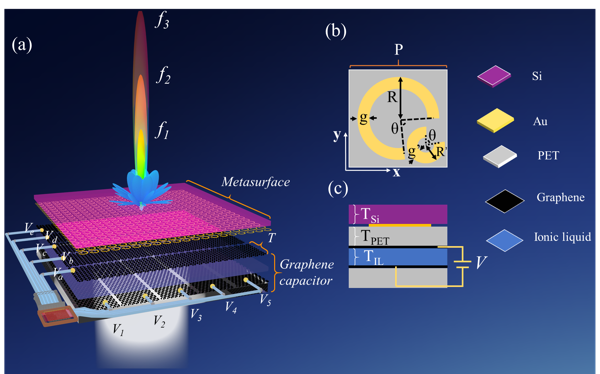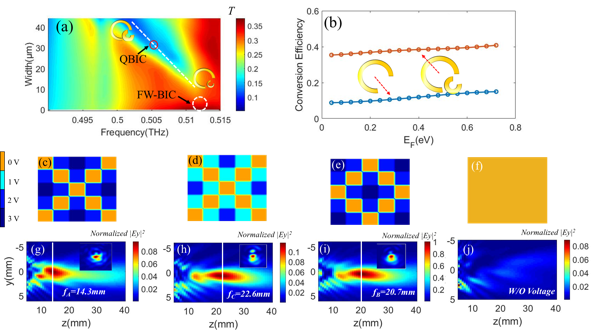Terahertz (THz) waves are known as electromagnetic waves located between infrared rays and microwaves, and THz technology has made significant advances in biomedicine, non-destructive testing, imaging, and high-speed wireless communications. However, the lack of modulators is still one of the bottlenecks in the development of THz technology. Recently, researchers adopted metasurfaces based on tunable materials to solve this problem. Graphene is a two-dimensional tunable material. Since the band structure and optical properties of graphene can be modulated by applying a gate voltage, graphene becomes a good tunable optoelectronic material. Graphene-based active metasurfaces have the advantages of fast tuning speed, high transmittance, ultra-small thickness, and good response to THz waves due to intra-band transitions, which offer great application potential for THz wavefront control.
However, graphene-based THz metasurfaces with metal antennas still face two problems. One is the lack of independent tuning modulation. Most of these metasurfaces use an entire layer of graphene and apply a uniform gate voltage for tuning, thus the modulation of each unit on the metasurface cannot be changed independently. The other problem is that the interaction between THz waves and graphene-based active metasurfaces is still not good enough.
To solve the above problems, the research group of Bin Hu from Beijing Institute of Technology and the research group of Yan Zhang from Capital Normal University proposed an electrically controlled enhanced active THz wavefront modulator. The device is composed of a 5×5 array capacitor formed by 10 graphene ribbons and a metasurface composed of a double C-shaped metal antenna array. The transmitted THz wavefront can be reconstructed by electronically modulating the graphene capacitor in an addressing way, thus realizing independent pixel modulation of the THz wavefront. The quasi-bound states in the continuum (QBIC) mode are introduced by designing a double C-shaped metal antenna array to enhance the interaction between THz waves and the metasurface, thereby achieving efficiency enhancements. The research results were published in Photonics Research Volume 11, No. 7, 2023(Jianzhou Huang, Bin Hu, Guocuo Wang, Zongyuan Wang, Jinlong Li, Juan Liu, and Yan Zhang. BICs-Enhanced Active Terahertz Wavefront Modulator Enabled by Laser-Cut Graphene Ribbons[J]. Photonics Research, (2023), 11(7): 1185).
This work integrates the two functions of efficiency improvement and dynamic reconfigurable of THz waves into a single device. The schematic structure of this THz modulator is shown in Fig. 1(a), which includes two layers. The top layer is a metal double C-shaped antenna metasurface, and the bottom layer is a 5×5 array of graphene capacitors. The double C-shaped antenna array interacts with THz waves to generate QBIC resonance, which enhances the conversion efficiency. To realize the phase-tunable effect, a 5×5 graphene capacitor array is placed close to the antenna metasurface, which consists of two groups of 5 parallel graphene micro ribbons. Therefore, pixelized THz wavefront modulation based on BICs resonance enhancement can be achieved when different gate voltages are applied to ten graphene ribbons.

Fig.1. Schematic of the reconfigurable THz wavefront modulator. (a)The structure consists of a double C-shaped metal antenna array and a 5×5 array of graphene capacitors composed of 10 graphene ribbons; (b) Top view of one unit cell with the double C-shaped antenna; (c) Side view of the structure.
To increase the efficiency of the interaction between the metasurface and the THz wave, the researchers proposed a double C-shaped antenna, as shown in Fig.2 (a)-(b). This structure utilizes the FW-BIC resonance to localize the incident x-polarized THz wave in a bound state on the surface of the structure, thereby enhancing the interaction with the metasurface and achieving conversion efficiency enhancement under different graphene chemical potentials. In addition, to design a reconfigurable THz wavefront phase modulator, dynamic phase modulation is also necessary. Therefore, based on the laser cutting graphene technology, the researchers fabricated a 5×5 pixelated reconfigurable THz wavefront modulator. The phase profile can be modulated by switching the mode of the graphene gate voltages, and the experimental results are shown in Fig.2 (c)-(j). Under different applied voltage modes, the device can realize the focusing of the THz wave and change the focal length.

Fig.2. (a) The transmission spectrum of the double C-shaped antenna with different outer radius R' proves that the structure introduces the QBIC resonance mode; (b) Comparison of the conversion efficiency of the double C-shaped antenna and the single C-shaped antenna at different graphene chemical potential with f=0.504THz (the conversion efficiency of double C-shaped antenna is improved due to the introduction of QBIC); (c) - (f) Four modes of the reconfigurable modulator, and the graphene voltage distribution for each mode is represented by the 5×5 pixel map; (g) - (j) Experimental results in four gate voltage modes
Dr. Bin Hu said: "Terahertz technology can be widely used in wireless communication, biomedical detection, remote sensing, environmental monitoring, and other fields, which has great application value. The terahertz modulator proposed in this work provides an efficient strategy for flexible manipulation of terahertz waves, which provides new opportunities for high-degree-of-freedom terahertz detection and imaging, as well as high-rate 6G communication."
This research was supported by Beijing Municipal Natural Science Foundation (L223031) and National Natural Science Foundation of China (61875010).


